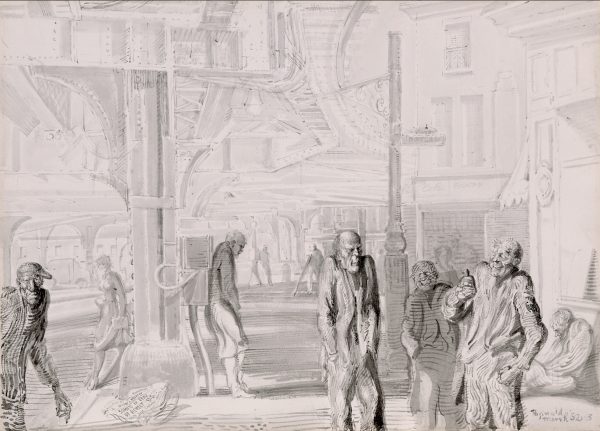
Bowery, The
Marsh, Reginald
1952–53
Artwork Information
-
Title:
Bowery, The
-
Artist:
Marsh, Reginald
-
Artist Bio:
American, 1898–1954
-
Date:
1952–53
-
Medium:
Ink on paper
-
Dimensions:
21 15/16 x 30 1/8 in.
-
Credit Line:
Wichita Art Museum, Roland P. Murdock Collection
-
Object Number:
M152.58
-
Display:
Not Currently on Display
About the Artwork
In The Bowery Marsh captures on paper the lives and living conditions of the residents of New York City’s “Skid Row.” The scene is set on a street corner located under a bridge or subway platform, but the buildings lack any real substance and seem to be on the verge of dematerializing. The people on the street are more solidly drawn than the architecture and most occupy the foreground of the picture. Worn and disheveled, they are obviously poor, and many are probably homeless. Several stand around idly. One man, holding a bottle, seems to be laughing and talking to himself. Another lies slumped against a building, perhaps in an alcoholic stupor. Marsh focuses here on the lowest of the low, literally and figuratively beneath the city that passes above their heads.
In his art Marsh would often depict loud, chaotic, urban crowds in which bodies press together on busy streets and subway platforms. But the figures in The Bowery do not touch; each person exists in a separate space and does not interact with anyone else. These people do not even appear to have any desire to communicate with each other. Several of them seem to be merging with the surrounding architecture: in the center of the image one man’s body takes the S-shape of the mechanical box on which he leans, while another figure, with his hands in his pockets, stands as rigidly as the pole behind him. Marsh perhaps suggests that these people are as much a part of the environment as the buildings that surround them every day and are easy for the more fortunate city dwellers to walk past or ignore. For example, the one fashionably dressed person in the scene, the woman on the left, hardly glances back at the vagrants as she strides across the street.
Marsh has been aptly described as the “American Daumier.”1 Like Daumier and many other nineteenth-century European journalistic illustrators who were an inspiration to him, Marsh was a sharp-eyed observer of the human foibles he saw around him, and occasionally would include subtle political commentary in his work. In The Bowery, such commentary is made through the inclusion of the Daily Mirror that lies on the sidewalk. Its main headline declares: “Soviets in Fear of Revolt—U.S.” Smaller headlines read “State Dept. Explains Jewish Purge” and “Report HST Will Spare Rosenbergs.” The Cold War worries of the United States government reported by the newspaper are, of course, completely irrelevant to the daily lives of the Bowery derelicts. Marsh juxtaposes newspaper announcements of Cold War political anxiety with an image of the harsh realities of slum life and asks us to decide which problem is more immediately pressing.
1. W. Benton, “American Daumier,” Saturday Review,” 24 December 1955, pp.8-9